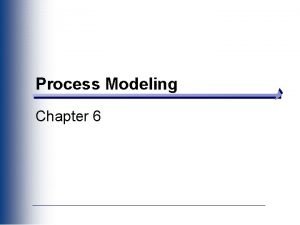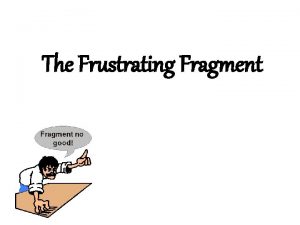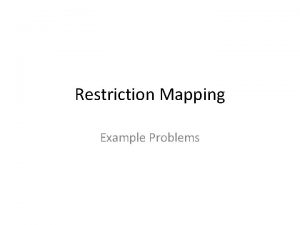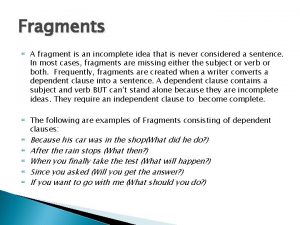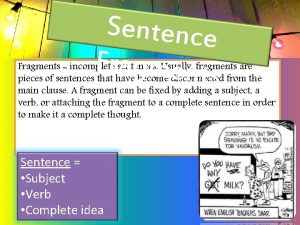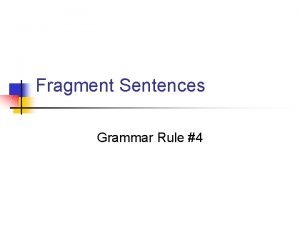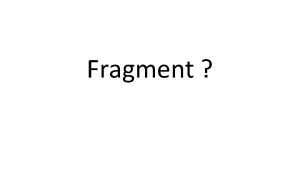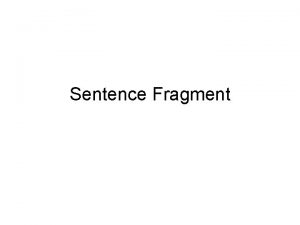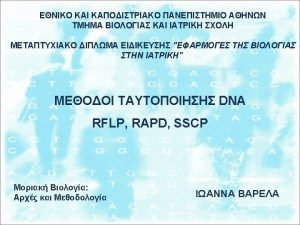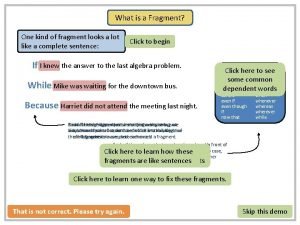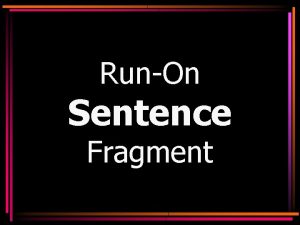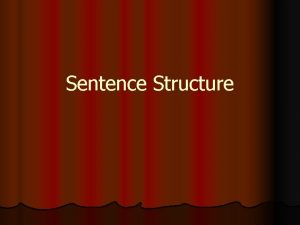Fragment What is a Fragment View 1 View














- Slides: 14

Fragment ?

What is a Fragment? View 1 View 3 Activity 1 Activity 2 View 4 Before android 3. 0 , If you have to show View 3 and View 4 you have to create new activity

Fragments • A Fragment represents a behaviour or a portion of user interface in a Fragment. Activity. You can combine multiple fragments in a single activity to build a multi-pane UI and reuse a fragment in multiple activities. • You can think of a fragment as a modular section of an activity, which has its own lifecycle, receives its own input events, and which you can add or remove while the activity is running (sort of like a "sub activity" that you can reuse in different activities). • A fragment must always be hosted in an activity and the fragment's lifecycle is directly affected by the host activity's lifecycle.

Fragments • For example, when the activity is paused, so are all fragments in it, and when the activity is destroyed, so are all fragments. However, while an activity is running (it is in the resumed lifecycle state), you can manipulate each fragment independently, such as add or remove them. • When you perform such a fragment transaction, you can also add it to a back stack that's managed by the activity—each back stack entry in the activity is a record of the fragment transaction that occurred. The back stack allows the user to reverse a fragment transaction (navigate backwards), by pressing the Back button.

What is a Fragment? View 1 View 3 View 2 View 4 Fragment 1 Fragment 2 Activity 1 Now, just insert fragment or delete it and insert another fragment. Fragments are so much customizable.

What is a Fragment? Fragment is a chunk of UI. It has its own Lifecycle. It can process its own events It can be added or removed while the Activity runs. • It was introduced in Honeycomb API 11. • You can use Fragments on older devices using a Support Library from 1. 6 to 2. 3 • • ACTIVITY FRAGMENT 1 List. View FRAGMENT 2 Image. View

Why do you need Fragments ? • Combine Several Fragments in One Activity • Reuse the same Fragment across several Activity • Make better use of larger screen space on tablets

Uses of Fragments? • Flexible user interfaces across different screen sizes • Fixed/Scrolling/Swipe tab displays • Dialog boxes

How to make a Fragment ? • Extend Fragment class • Provide apperarance in XML/Java • Override on. Create. View to link the appearance. • Use the Fragment in XML/Java(Dynamically).

Activity On. Create Fragment on. Attach is called after Fragment is 1 2 On. Attach 4 On. Create 5 on. Create. View 3 On. Attach. Fragment 6 on. Start on. Resume on. Activity. Created associaiated with its Activity Gets a reference to the Activity object which can be used as Context. on. Create. The system calls this when creating the fragment. You should initialize essential components of the fragment that you want to retain when the fragment is paused or stopped, then resumed. on. Create. View. You are expected to return a View Hierarchy for your fragment 7 8 on. Start 10 on. Resume 9 on. Activity. Created Called after Activity on. Create has completed execution Use this method to access/modify UI elements.

Activity Fragment 1 on. Pause 2 3 on. Save. Instance. State 4 5 on. Stop 6 7 on. Destroy on. Pause 10 on. Destroy. View 8 on. Destroy 9 on. Detach on. Save. Instance. State Use this to save information inside a Bundle object. on. Destroy. View Called after the Fragment View Hierarchy is no longer accessible on. Destroy Called after fragment is not used. It still exists as a java object attached to the Activity on. Detach Fragment is not tied to the Activity and does not have a View hierarchy

The Fragment Manager Every Activity has its own Fragment Manager Accessible through get. Fragment. Manager() It maintains references to all fragments inside the Activity Use find. Fragment. By. Id() or find. Fragment. By. Tag() to get reference to a particular Fragment Manager Fragment 1 Fragment 3 Fragment 2

Fragment Transactions Fragement Manager Changes to the UI in terms of adding, Removing and replacing Fragments are Conducted as Fragment. Transactions Begin a transaction begin Add, remove, replace whatever fragments you want Fragement A Commit the transaction commit

Questions ?
 Na schematach przedstawiono ten sam etap dwóch typów
Na schematach przedstawiono ten sam etap dwóch typów Okazaki fragment
Okazaki fragment Dfd fragments examples
Dfd fragments examples What is added detail fragment
What is added detail fragment Ip fragmentation and reassembly
Ip fragmentation and reassembly Apostrophe figure of speech example
Apostrophe figure of speech example Restriction fragment length polymorphism
Restriction fragment length polymorphism Fission fragment rocket
Fission fragment rocket Infinitive phrase fragment
Infinitive phrase fragment Sentence fragment identifier
Sentence fragment identifier Fragment onrestart
Fragment onrestart Sentence fragment examples and corrections
Sentence fragment examples and corrections Fragment definition grammar
Fragment definition grammar Muratorian fragment
Muratorian fragment Whats a fragment sentence
Whats a fragment sentence


